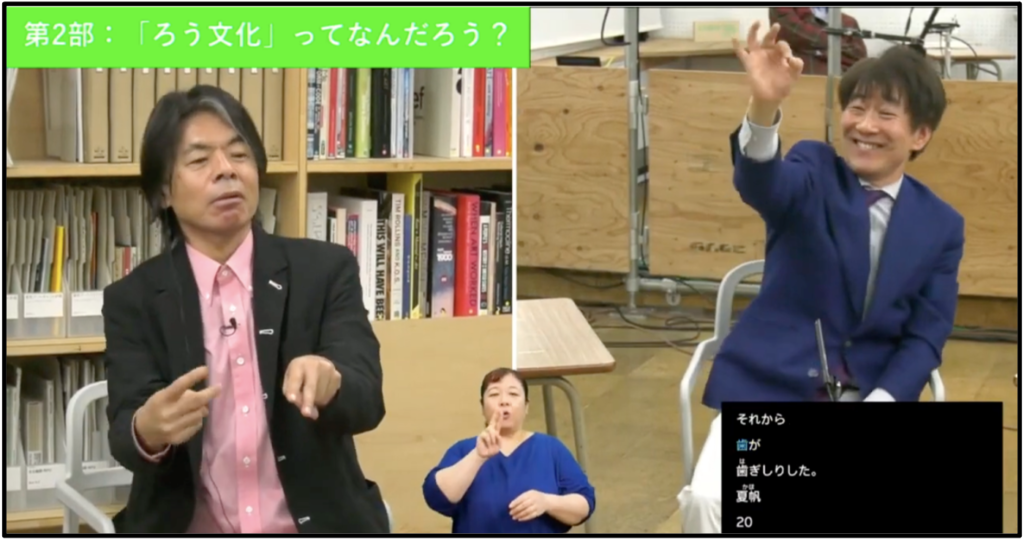
“TURN Meeting” is a series of talks which feature different guests each time.
TURN Meeting No.12, held on Sunday, November 29, was held online like the previous one.
The theme for this meeting was “What is “Deaf Culture”? Conversing with the hands?” We explored the world of communication with and among deaf people; a combination of methods including sign language, facial expression, and movement of the whole body which creates a rich “language.” Together with guests Hideaki Nasu, an actor/sign language news anchor, Shuwa Friends representative Monkey Takano, and sign language interpreters Yumiko “Ra-chan” Takashima, we considered a form of communication whose approaches and delights differ from conversation through sound.
We report on the proceedings, which involved discussions on a variety of forms of
communication and methods of expression.
■An exercise in diverse accessibility
In response to the pandemic, this meeting was also held online as previous. In a continuation from the previous event, which was an experiment in how to provide a rich level of accessibility on one screen, the room was filled with a flurry of different “languages.”
Firstly we will provide an introduction to the set-up in 3331 Arts Chiyoda ROOM 302 from where we streamed the event. At the front of the room was moderator Laila Cassim and TURN Project Director Tsukasa Mori. Near the wall on the corridor side were barrier-free “Katsubens” Kotaro Dan, providing live narration and audio description for the event, and four sign language interpreters. In the same way as before, sign language interpretation entailed a hearing interpreter first converting the speaker / performer’s words into sign language, and then relayed to a deaf “sign language navigator” who would convert the interpretation into native sign language, which would be delivered to viewers.
Additionally by the back window were guests Nasu, Takano, and Ra-chan, as well as two interpreters converting the signing of Nasu and Takano, who are deaf, into speech. Hibino sat in a group forming a circle. Onscreen was a realtime speech-to-text display of what was being said.
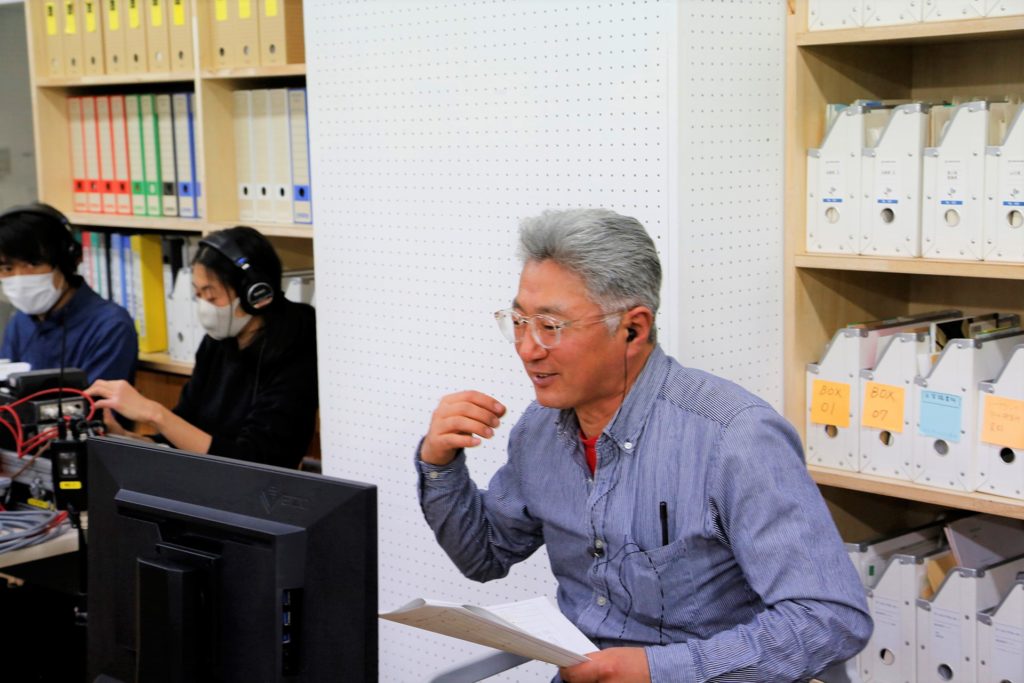
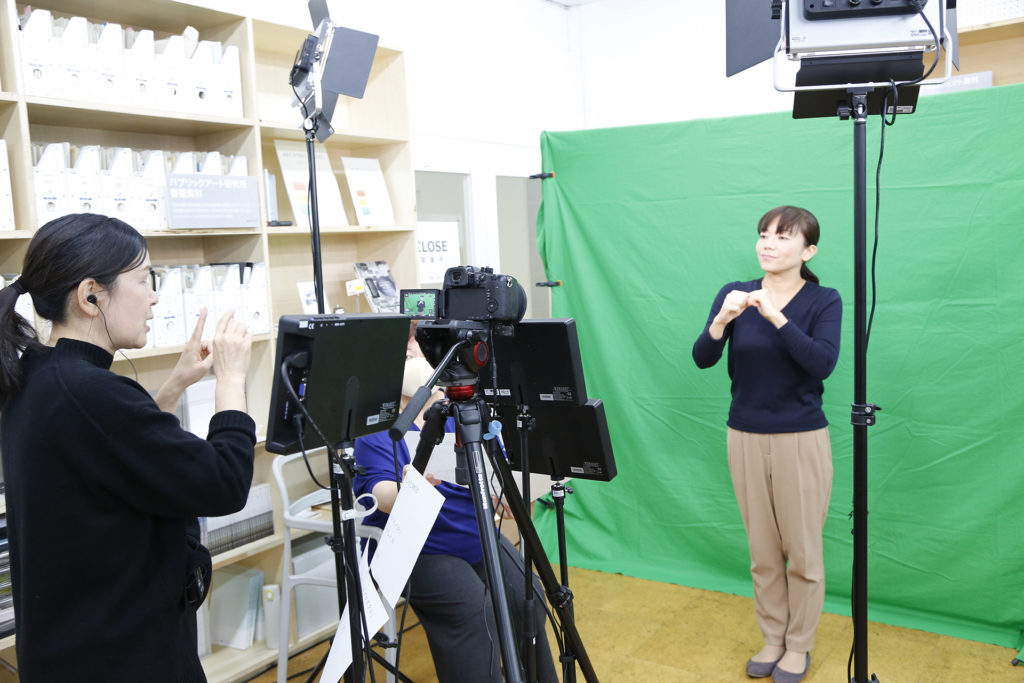
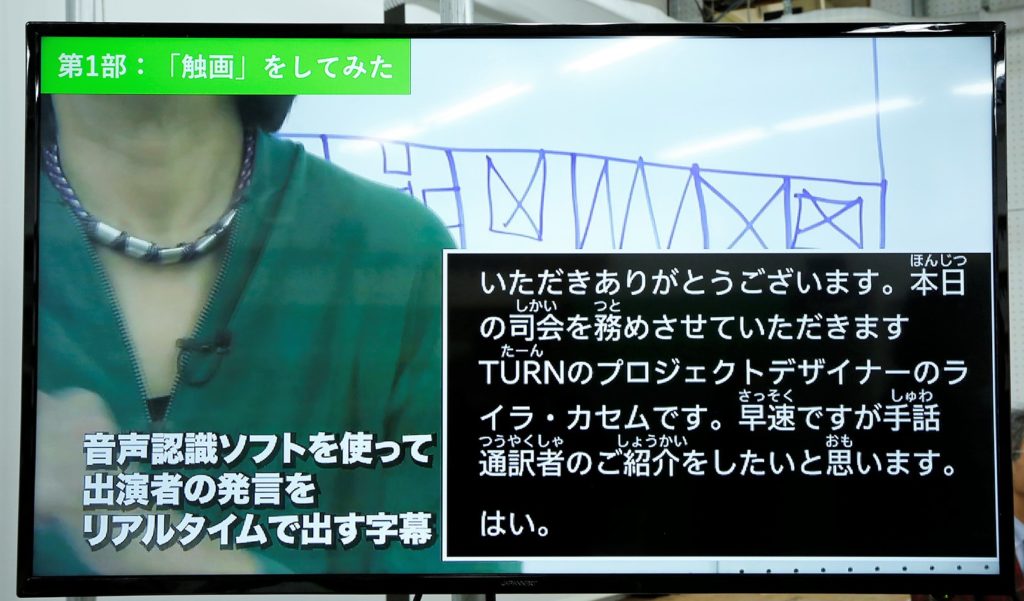
Debate became quite lively during the rehearsal two hours prior to the event, in terms of how to communicate such an array of “languages” to viewers with diverse backgrounds and circumstances. One of the most talked-about issues was what to do about the onscreen placing of guests who use sign language.
Unlike verbal conversation, in order to deliver signed conversation to viewers, the signer needs to face the camera. However, if you have two cameras following three signers individually, due to the speed of the conversation inevitably there will be a time-lag when switching cameras. We made the necessary tweaks until just before the actual event, such as setting up wide shots of multiple people instead of showing guests individually onscreen.
■ What came apparent through “tactile painting”
At 17:30 the live stream started. In Part 1, we started off with a video showcasing the technical experiments devised in the previous TURN Meeting, followed by footage of the “tactile painting” recently created by Hibino based solely on his sense of touch and without using his sight.
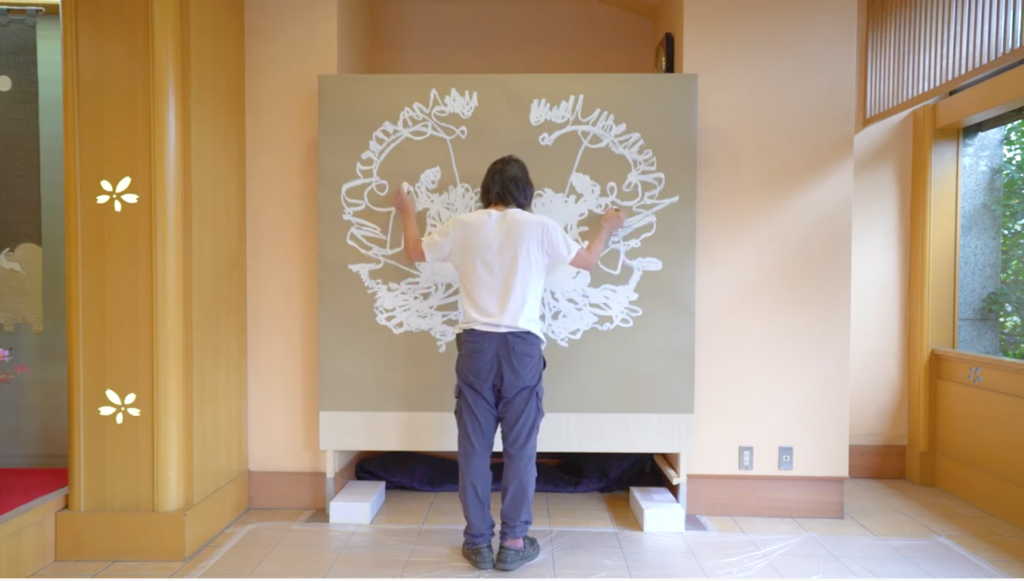
Hibino explained that his attempt at tactile art was inspired by meeting guest Atsushi Mori at the previous TURN Meeting. Mori who is deafblind, understands the world through the sense of touch instead of sight and sound, said during his discussion with Hibino that “for a deafblind person, things you cannot touch do not exist.” Intrigued by what Mori said, Hibino decided he wanted to engage in a tactile-based experience himself.
The “tactile painting” video shows Hibino standing with his eyes closed in front of a large thick piece of cardboard. With a white oil stick in each hand, he begins to draw mirroring symmetrical lines from about waist height in a zig zag pattern, and then as he spreads out his arms the drawn line follows the trajectory of his hands to form a sort of circle.
Hibino: “Rather than being about ‘what to draw’, it was more a question of the method I used to draw. Facing the board I made paint marks on it by moving my body, and this way I was able to create a symmetrical picture within a range I could physically reach. While I was drawing, I relied solely on the sensations in my hands, such as the pleasant smooth feel of the oil sticks and the tiredness of my arms when I raised them. I still had visual memory of course, so in some ways I balanced out the picture using my imagination, but I don’t think that I would have been able to produce this drawing with my eyes open. At the same time, after drawing the picture, I felt what I think people who are deafblind must feel, that the only sense you have left is the sense of touch. It was an experience that made me think about the broader question of what a ‘picture’ really is.
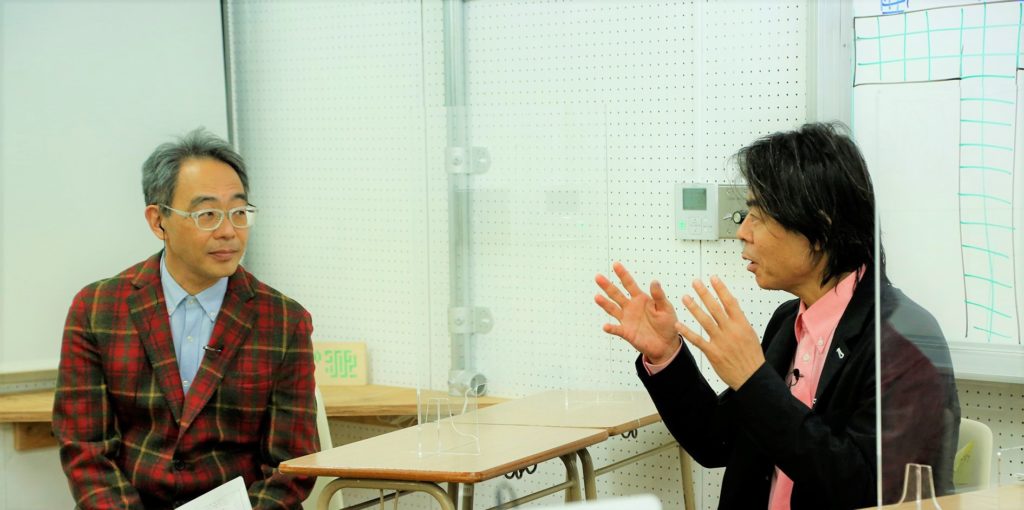
Mori, who was there to watch Hibino creating his “tactile painting,” described Hibino at work as “like somebody conducting music.” Mori reflected that the key concept he had taken away from the previous TURN Meeting had been “touch.”
*Click here for archived footage of TURN Meeting No.11
*Click here for TURN Meeting No.11 report
■The Rhythm of Rap, the Rhythm of Sign Language
Next in the program, “rap creator” MACHEE DEF talked about the rap he had created during his online interactions with users of a welfare facility during the pandemic.
MACHEE DEF made his entrance while laying down a freestyle rap. At one stage barrier-free “Katsuben” Dan gave a vivid verbal snapshot of MACHEE DEF’s clothes, which MACHEE DEF built upon with an improvised rap. This unique collaboration between two professional wordsmiths created a lively light-hearted mood in the room.
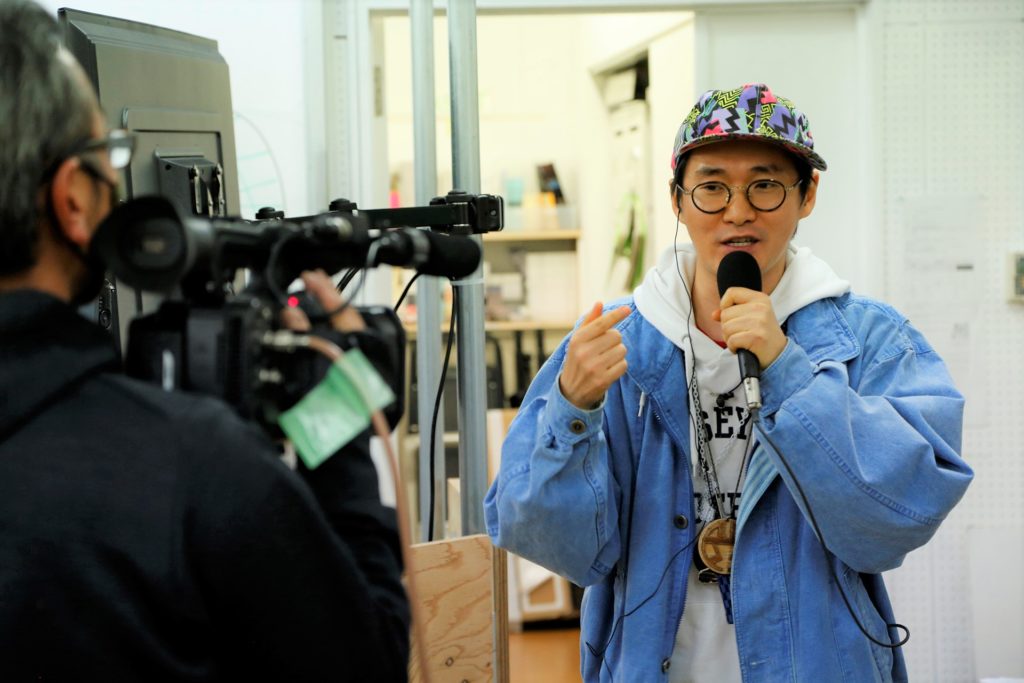
MACHEE DEF has participated in TURN since last year, continuously interacting and working with the facility users at Toshima Welfare Home Sakuranbo (for physical and learning disabled people) in Ikebukuro ward, Tokyo. Following the outbreak of COVID-19, from February 2020 he shifted his Interactive Program activities online. Together with facility users and graduates, he created a rap for the annual Sakuranbo Festival held at the facility: called “Rimo-oto Sakuranbo” (“Remote sounds of Sakuranbo”).
He also performed the “Rimo-oto Sakuranbo” rap live in the streaming room, parading around the room with guests and staff taking part in the rap technique known as “call and response”. For the hook, he spelled out the lyric “Sa-ku-ran-bo” using fingerspelling. As well as a display of the rap lyrics, an onscreen graphic gave a visual representation of the gradation of beats so that hearing-impaired audiences could also enjoy the performance. It was a live performance filled with experimentation, including the visual experiment of projecting a picture of cherries (sakuranbo) behind MACHEE DEF on the screen.
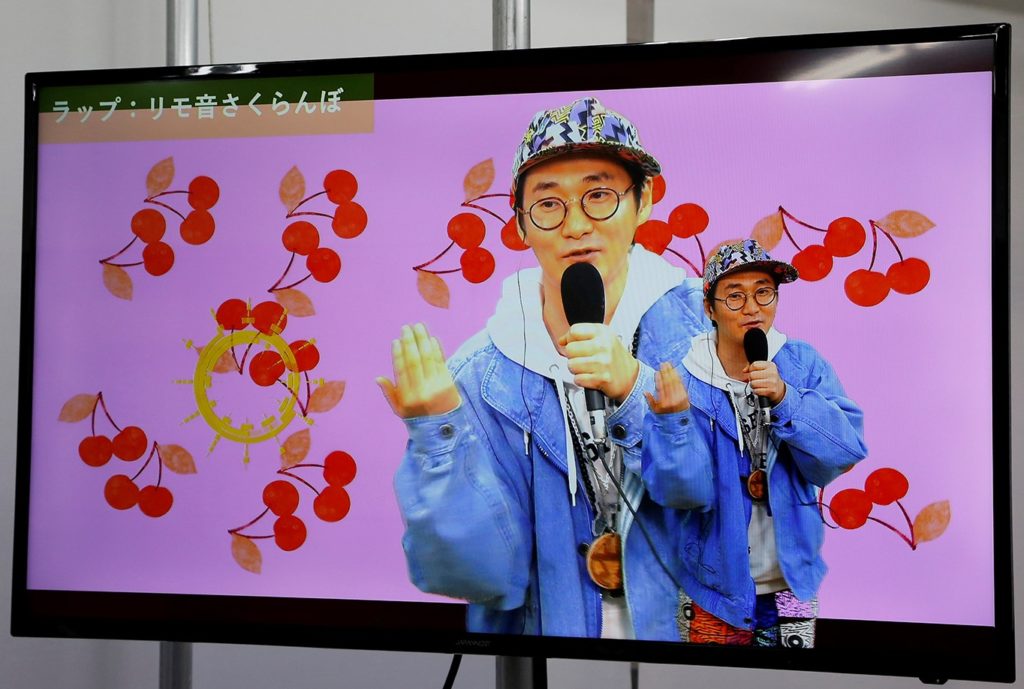
MACHEE DEF apparently had a four and a half-hour long discussion with the deaf sign language navigators about his live performance. In the process, he deepened his understanding of sign language, which he had no previous knowledge of, as a language in its own right just like Japanese and English. He said he had thought about how to enjoy rap with deaf people for this live performance.
MACHEE DEF: What I noticed in dialogue with deaf people that sign language also has rhythm. I’m sensitive to rhythm to the point that my body starts swaying when I hear the sound of a level crossing, but the hand movement of deaf people is rich in rhythm and has something in common with rap. In my rap for this event, I tried to make something that could be enjoyed visually, based on that discovery.In future I want to take on the challenge of converting sign language into rap, rather than converting rap into sign language.
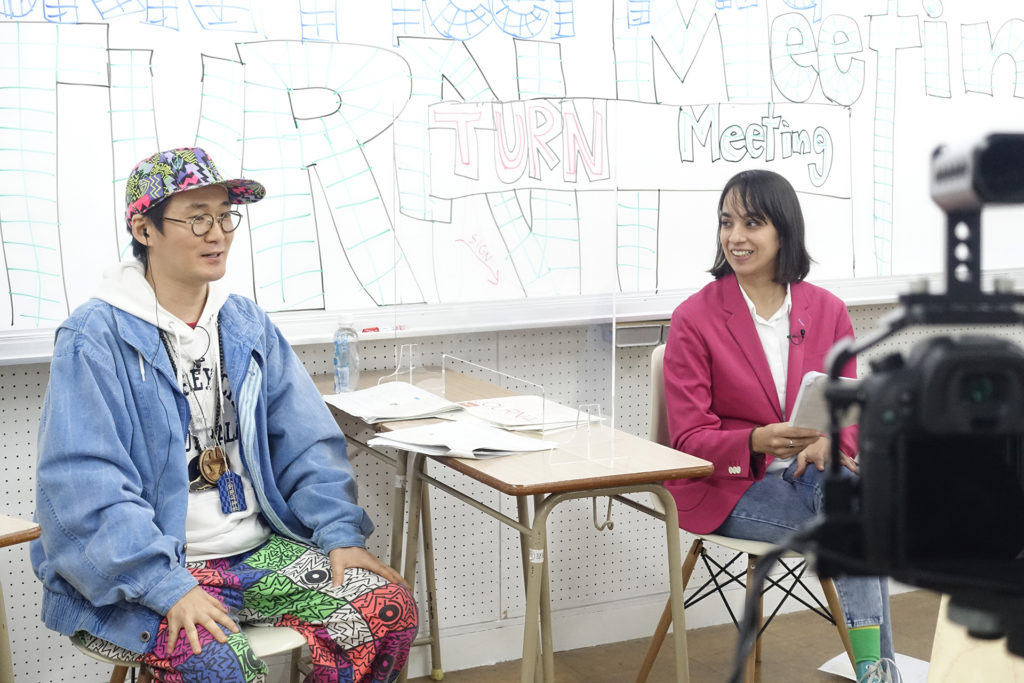
■Experiencing deaf communication for ourselves
In Part 2, Nasu, Takano, Ra-chan and Takashima joined Hibino to discuss the day’s theme of “deaf culture.”
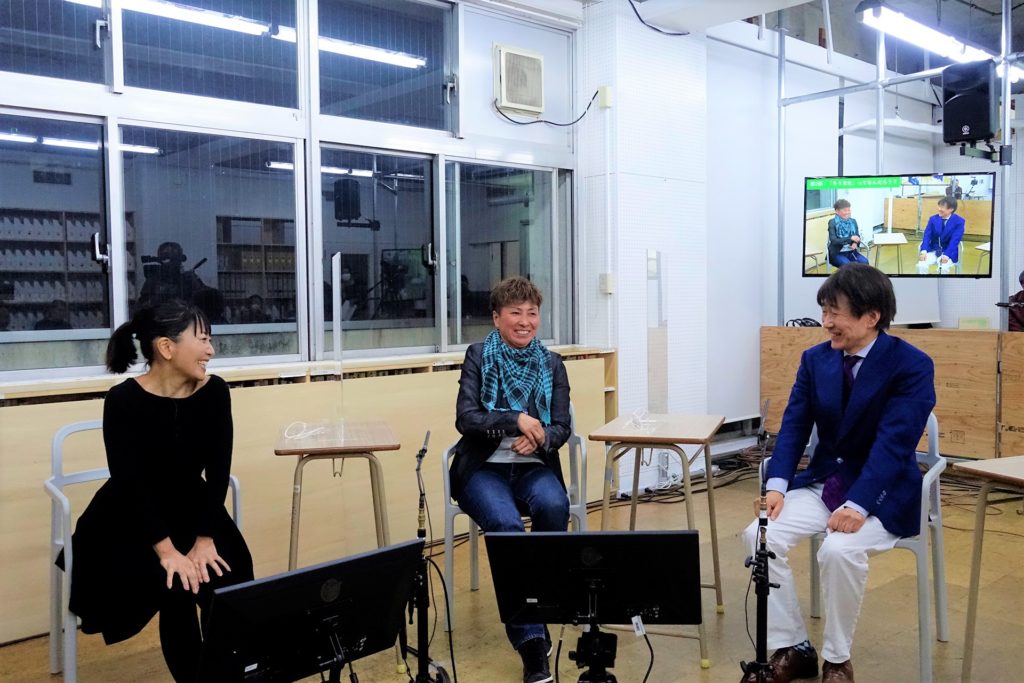
Hibino apparently first encountered the term “deaf culture” through Eri Makihara, the director of LISTEN, a 2016 documentary film which explores the world of deaf music.
Hibino: “The word ‘culture’ is often attached to periods in history or regions, as in ‘Heian culture’ or ‘Japanese culture’.” So it left a big impression on me when Eri Makihara told me that in the same way, there was a deaf culture. In today’s event I’d like to find out about and enjoy the ways that deaf culture differs from the culture of hearing people.”
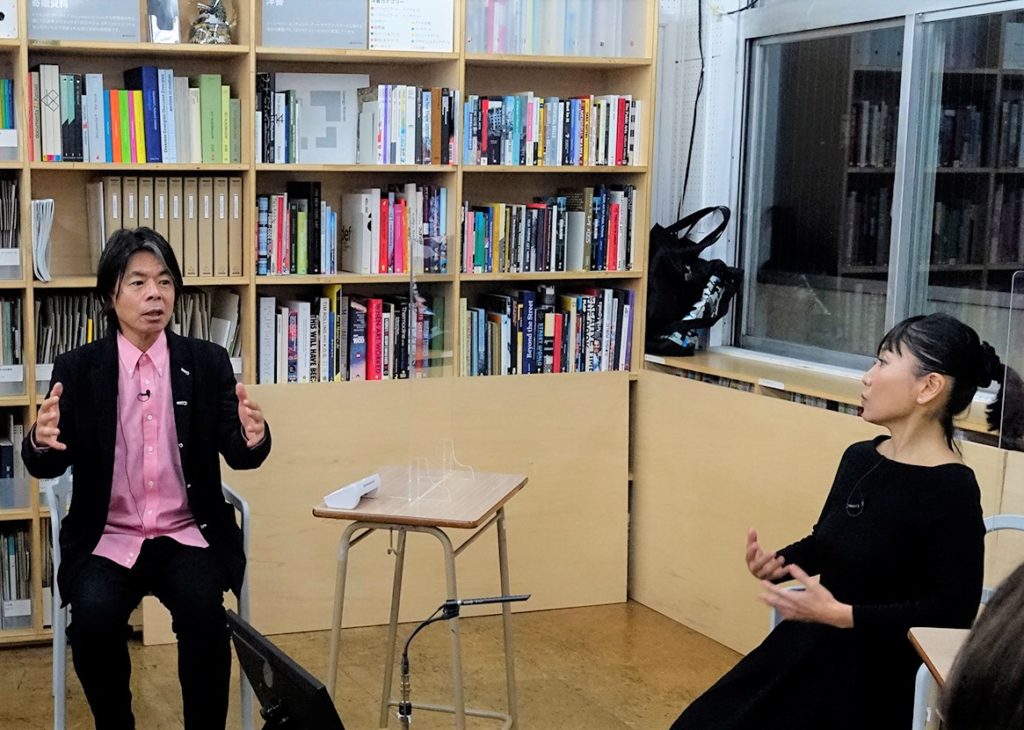
Nasu has been deaf since he was two, and Takano since birth. Meanwhile sign language interpreter Ra-chan, who is also Takano’s partner, is in the position of being a hearing person in a relationship with a deaf person. Ra-chan says she is not particularly conscious of “deaf culture,” but when she started learning sign language, she found it hard to get used to the “pointing” gestures required for sign language communication.
Ra-chan:”When indicating an object as a hearing person, you indicate it to each other verbally using words like “that” or“it,”but deaf people have to point with their finger. I’m used to it now, but at first it startled me. On the other hand there are lots of situations when sign language is convenient. For example, when I went to a disco with some deaf friends. If you are in a loud place and far away from each other, you can still talk using sign language. I also remember how much my friends were enjoying the vibrations of the disco.
Takano agreed with Ra-chan, saying, “I also like noise vibrations. Sometimes I enjoy karaoke by signing the meaning of the lyrics.” In response Hibino mentioned that deafblind Atsushi Mori had told him he preferred trains that swayed and jolted a lot because it gave more of a sense of the train moving. The significance to non-hearing people of the information carried in vibration is something that interests Hibino.
Our other guest, Nasu, does one-man shows and theater alongside working as an television anchor for “NHK Sign Language News 845”. In his stage work, he sometimes translates Japanese-language scripts into sign language, but he says that there are times when it is difficult to convey meaning using existing sign language alone. For example, he said if you replace the literal meaning of the lyrics in the folk song “Hotaru no hikari” (“glow of a firefly”, Japanese adaptation of the Scottish folk song “Auld Lang Syne”) with ordinary sign language, it’s hard for a deaf person to make sense of it, and with that he demonstrated the meaning of the lyrics to “Hotaru no hikari” in comprehensible sign language.
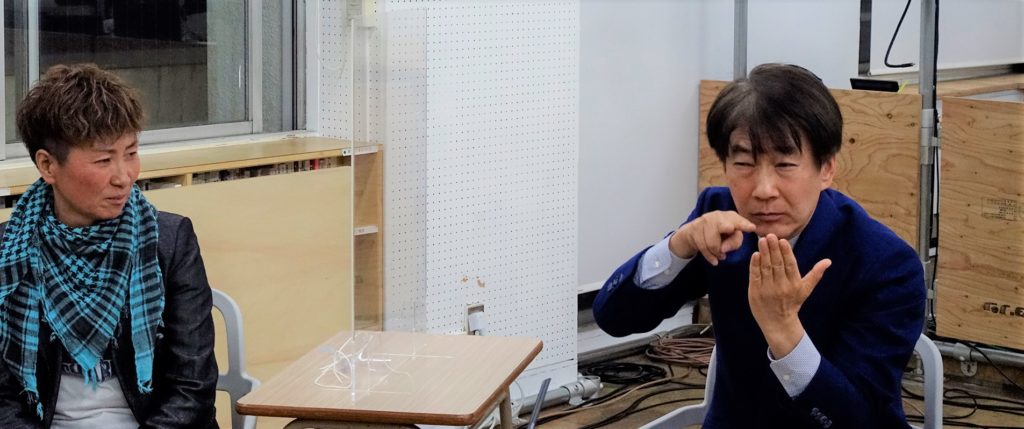
The expression of the lyrics using sign language was fascinating. He was expressing “firefly” when he crossed his wrists with his higher hand balled in a fist, index finger raised, and spread the fingers of his other hand, while opening and closing them like pulsating light. Then he drew a square in the air with his fingers to indicate a “window.” Moving his hands down in a fluttering motion expressed “snow.” Hibino excitedly exclaimed, “I get the meaning!” When he copied Nasu’s movements, reproducing the first lines of the song with his hands and not his voice, Nasu also excitedly pointed at Hibino gesturing “Yes, that’s it!”.
Nasu: Take Ainu culture for example; Ainu people don’t think on the basis of Japanese, they think in the Ainu language. Similarly deaf people used to learn to communicate on the basis of communication with hearing people, but I think it’s more important to think of sign language as the basis of communication. It’s the same for my plays – I don’t convert them into Japanese but express meaning through a combination of visual images.
Next Nasu gave an improvised demonstration of the play “Tobira” (“Doors”). In it, Nasu warps to the ocean and the battlefield by doors that appear one by one in front of your eyes. There was no verbal explanation but we had a vivid picture of the scenes in our heads through Nasu’s movements.
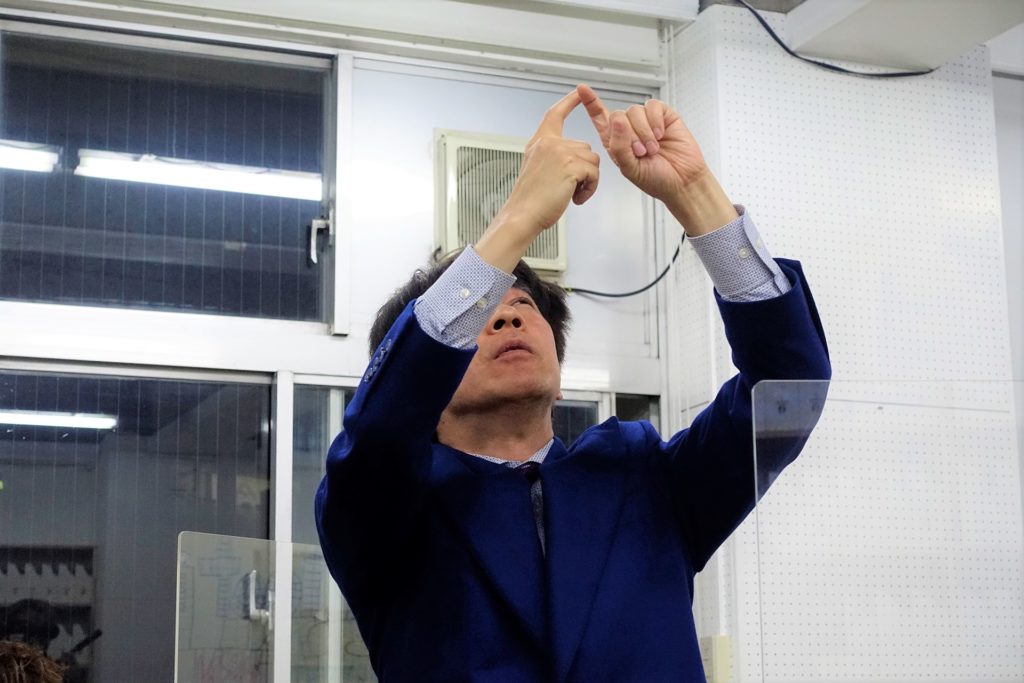
Nasu performed a play by first making a violent movement reminiscent of an aerial bombing, and then used both hands to make a shape in the air like a bird’s wing. This stayed with us, as if we had watched a short film. In response to this true-to-life performance, Hibino didn’t say anything but expressed his impressions through using his entire body.
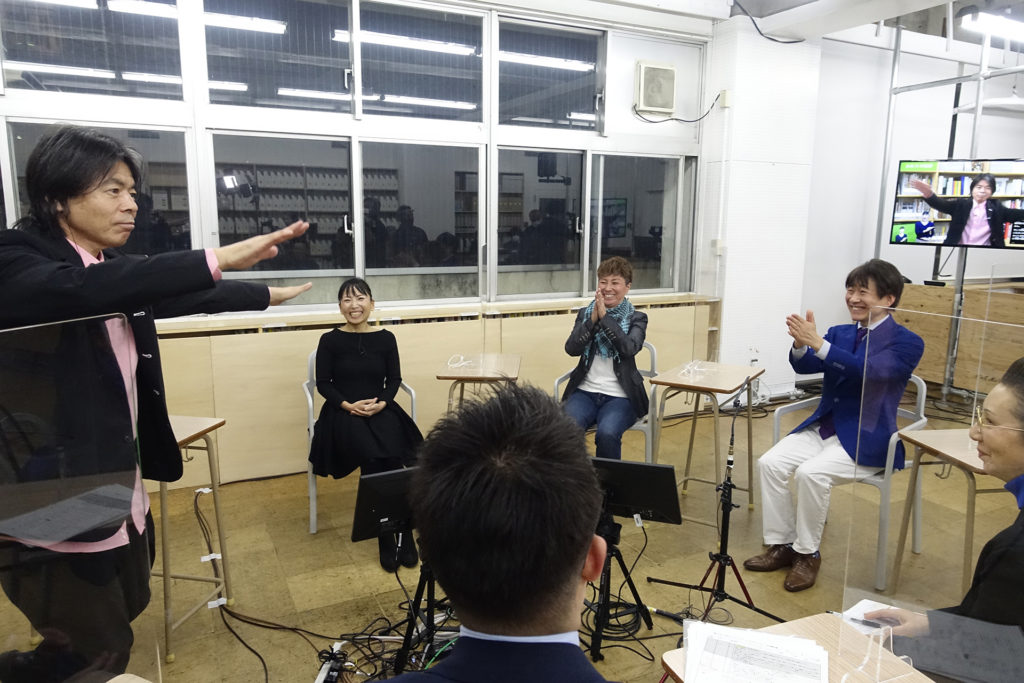
■Understanding Each Person’s Abilities, and Discovering the Charms of “Human Beings”
Hibino raised two points regarding the characteristics of deaf communication as he understood them from the discussion so far, and from Nasu’s performance.
Hibino: Firstly, it is very visual. In the expression of a certain scene, I felt that I was watching from a first person perspective, and then that I was looking at it from a bird’s-eye view, and it felt like the scenes were expressed through the switching between four or so inner mental cameras. Also, in order to convey a certain object or experience through movement, I felt that it was important for me to have the experience vicariously, and become the person having the experience.
Ra-chan nodded when Hibino made the point about deaf culture being visual. And on the subject of trying to trace the movement of something, Takano said: “I love doing imitations: monkeys, gorillas and chimpanzees all have different facial expressions and gestures,” and gave us a demonstration.
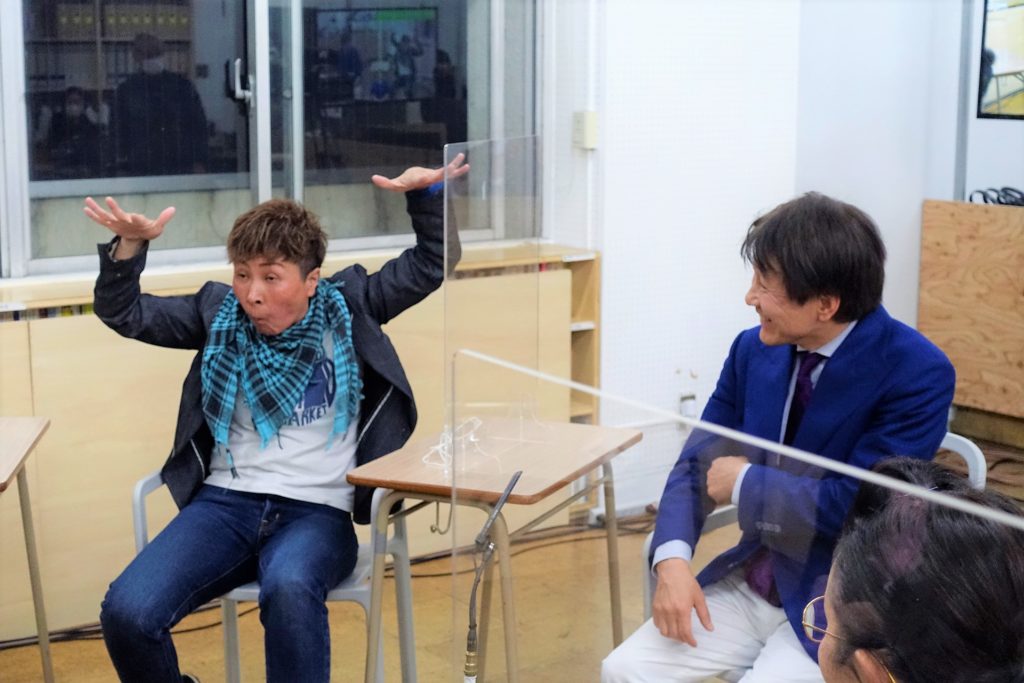
Takano: I love getting to grips with the characteristics of something and imitating it. Also when I’m teaching sign language, I convey the importance of learning not just how to sign but also how to use facial expression. In the same way that hearing people have “vocal expression” deaf communication also has “expression.”
Ra-chan: I feel that deaf people are very good at picking up on the characteristics of others. When they are trying to remember a person, they’ll remember people not by name but by the characteristics of the person’s appearance.
Nasu: Deaf people may not be able to hear but they get a lot of information visually, I think. Maybe the visual store we build up this way leads to expressive ability.
From there the conversation turned to the subject of the differences among deaf people’s individual sign language and facial expressions. Takano said Nasu’s way of signing was “very powerful and always inspiring,”to which Nasu’s response was:“Your imitation of a monkey is probably the best in Japan.”
Takano: It’s the differences that people have which make it interesting. I think we all express sign language in our own way. I believe it is very important to have mutual respect for the way we express ourselves.
Nasu:The same song can be sung in different styles and with different voices depending on the singer; likewise it may all be art, but Hibino-san, Van Gogh and Dali all show completely different styles and personality in their work.
Listening to this series of exchanges, Hibino said: “I’ve learnt that deaf people communicate through their bodies on the basis of their visual experience.To a large extent this is due to being able to experience this for myself today by imitating Nasu-san’s expressions.” And to finish, he summed up the possibilities offered by hearing people learning about deaf people’s communication and forms of expression as follows:
Hibino: Deaf people are adept at focusing on “seeing,” storing up what they “see” and using it as output, and this is one of the fascinating aspects of deaf culture I think. Human beings have a variety of abilities from the start, and both deaf and hearing people have their own special abilities. The interest that hearing people feel for deaf culture will also lead to us cultivating deaf culture together. I feel that it is important not only to embrace diversity but also to recognize the appeal of “human beings” in a broad sense.
■The importance of enjoying interaction on an equal footing
This was a TURN meeting in which we exchanged not only conversation but also expressions using the whole body in our exploration of communication surrounding deaf people. When I talked to guests from Part 2 after the event, I heard a lot of comments about how they were particularly impressed by Hibino’s curiosity, enthusiasm and balanced way of engaging with them as an interviewer.
Ra-chan, who has been involved in sign language for about twenty years, said “A lot of hearing people assume that non-hearing people are “unhappy,” and start off with the question “Is there anything I can do?” But Hibino-san’s even-handed approach had a great impact on me. Takano also expressed surprise, saying: “I got the feeling Hibino-san wants to know more about deaf culture than we do. He’s very expressive, and I think the energy and enthusiasm that allows him to absorb and articulate whatever we did is amazing.”
It is important that we interact easily with each other as people living in the same society, rather than stop or tense up in the face of our superficial “differences.” As Nasu said: “It would be great if more people in our society could enjoy interacting with deaf people like Hibino-san does, rather than do it in a stiff and formal way. I think it’s important not to think of deaf and hearing people as being different but for society to naturally accept that some people exist within it who use sign language, and for us to learn the good things about each other.”
The next event TURN Meeting No.13 is scheduled for March, 2021. So please keep a lookout !
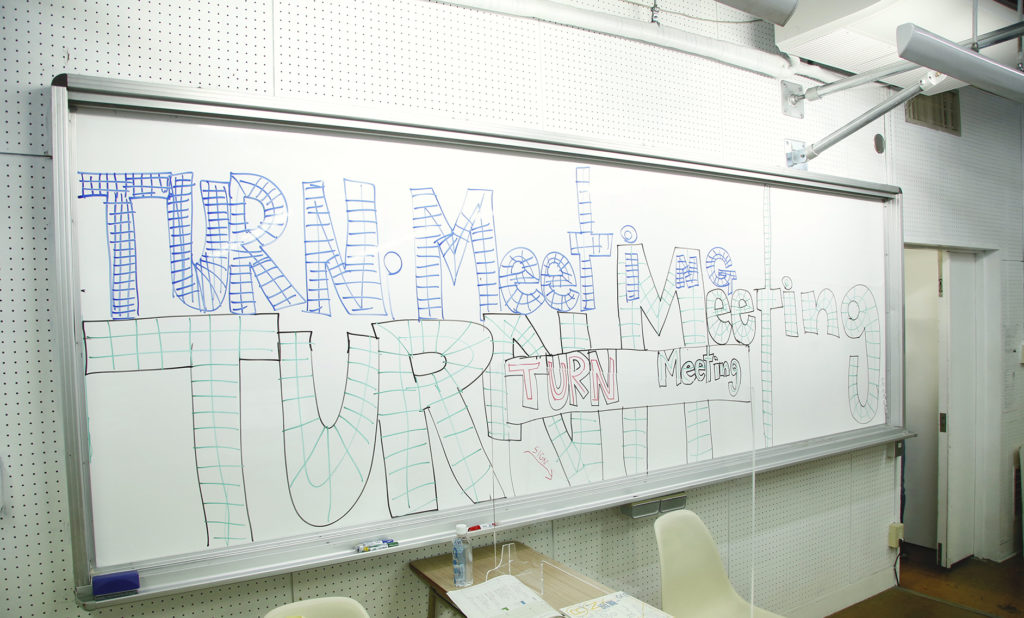
Written by Tamaki Sugihara
Photography by Shingo Kanagawa